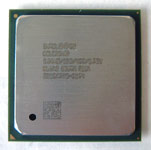Quake III Arena is a First Person Shooter (FPS)
that revolutionized gaming as we know it. Using multiple light sources and
having graphics textures that can fill videocards, even after 3 years it's still
able to bring a cutting edge system to its knees.
| Quake III Arena Fastest demo001 (SYSTEM) |
|
Motherboard (FSB) |
FPS |
Ranking |
| 1. |
P4 1.6A - 100 MHz |
253.4 |

|
| 2. |
Celeron - 100 MHz |
209.2 |
 |
| 3. |
Celeron - 125 MHz |
242.5 |
 |
| Quake III Arena Fastest nv15demo (CPU STRESS) |
|
Motherboard (FSB) |
FPS |
Ranking |
| 1. |
P4 1.6A - 100 MHz |
71.4 |

|
| 2. |
Celeron - 100 MHz |
59.6 |
 |
| 3. |
Celeron - 125 MHz |
69.5 |
 |
What we saw
in 3DMark is also happening here. The P4 thanks mainly to more cache outperforms the Celeron.
Conclusion:
The Celeron line of processors have always
been budget CPU's. With a retail price of just $146 CDN ($99 US) for an Intel
processor that's pretty inexpensive. It handles office based work perfectly
fine, especially some of the newer software with SSE2 code written in it.
If you're strapped for cash and need a low end Socket m478 processor to hold you
down, the Celeron 1.8 GHz CPU is a decent choice.
Because the L2 Cache is only half that (128KB for
Celeron) of a Williamette P4 (256KB Willy P4), in 3D based applications the
performance suffers. As we saw when we overclocked the processor, even at a
clock speed of 2.25 GHz the Celeron was unable to beat out a P4 1.6A (512KB L2
cache in Northwood P4's).
Overall, if
you're looking for a CPU to do word processing, web surfing, office work,
programming or similar work - the Celeron 1.8 GHz will serve you just fine.
If you're a gamer
or use a lot of sound, or
3D based applications invest in a full fledge Pentium 4. You'll certainly thank
yourself later when you're working.
Related Articles:
Here are a few other articles that you might enjoy
as well...
1. Intel Pentium 4 1.5
GHz
